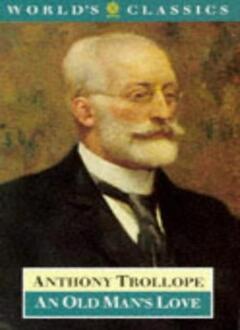
An Old Man’s Love (1884) was Anthony Trollope’s last completed novel, written in the year of his death and published posthumously. The eponymous “old man” is 50-year-old William Whittlestaff, who becomes guardian to Mary Lawrie, the daughter of a friend, and half his age. Against his better judgement, he falls in love with her, actively encouraged by his stickybeak housekeeper, Mrs Baggett. Mary already has a lover, however.
The penniless John Gordon has gone to seek his fortune in the South African diamond mines so he can return with sufficient means to make her his wife. As Mary has not heard from him in three years, she eventually bows to considerable pressure from Mrs Baggett and accepts Whittlestaff’s marriage proposal out of a sense of gratitude. Resigned to her fate, Mary is subsequently thrown into turmoil later that very afternoon when John Gordon makes a triumphant return, having put aside a tidy sum for their future. Mary dutifully stands by her acceptance of Whittlestaff’s proposal, and the onus is then on him to wrestle with his conscience: he is torn between his own desire for Mary and the knowledge that her heart belongs to his rival. Having been disappointed in love once before, Whittlestaff is reluctant to suffer rejection and humiliation for a second time, and he also fears for the steadiness of Gordon and his diamonds. After much soul searching, he eventually arrives at a decision in the best interests of everyone, and his equivocation leaves the reader unsure until the very end.
In a serio-comic subplot, Mrs Baggett is pestered by her drunken one-legged husband, Sergeant Baggett, who regularly importunes for money. Although they have been estranged for some time, he urges her to perform her wifely duty by paying for his gin and looking after him. As the novel was written in the year the Second Married Women’s Property Act was passed, these scenes could be seen as demonstrating exactly why wives should be able to control their own earnings. Mrs Baggett is a born martyr, however, and repeatedly submits to her fate in melodramatic fashion. She places the interests of Mr Whittlestaff above all else, and fantasises that he will break his leg so she can fulfil his every need.
The main plot seems to have been inspired by Trollope’s feelings for his friend Kate Field, an American feminist 23 years his junior. In her superb biography of Trollope, Victoria Glendinning expresses her belief that Trollope was too scared to make Whittlestaff closer to his own age (67), possibly fearful of autobiographical readings1 (and presumably a severe handbagging from Mrs Trollope). Putting his potentially adulterous feelings to one side, Trollope shows poignantly how an older man can still be capable of passion and great dignity. While writing the novel, Trollope was struggling with ill health, and much of it was dictated to his niece, Florence Bland. The Oxford World’s Classics edition helpfully indicates those passages written by the author himself, and those that were originally in the hand of his amanuensis.
It’s hard to read An Old Man’s Love without an overwhelming sense of sadness: later that year, Trollope suffered a fatal stroke after laughing uproariously at a reading of F. Anstey’s comic novel Vice Versâ. However, this novel is one of his finest, showcasing his talent for characterisation, pathos and mischievous wit. The Times wrote in their review: “we are glad to think that the last of Trollope’s works should leave us with agreeable memories of its writer at his very best.” Quite.
An Old Man’s Love by Anthony Trollope
Trollope by Victorian Glendinning ↩︎